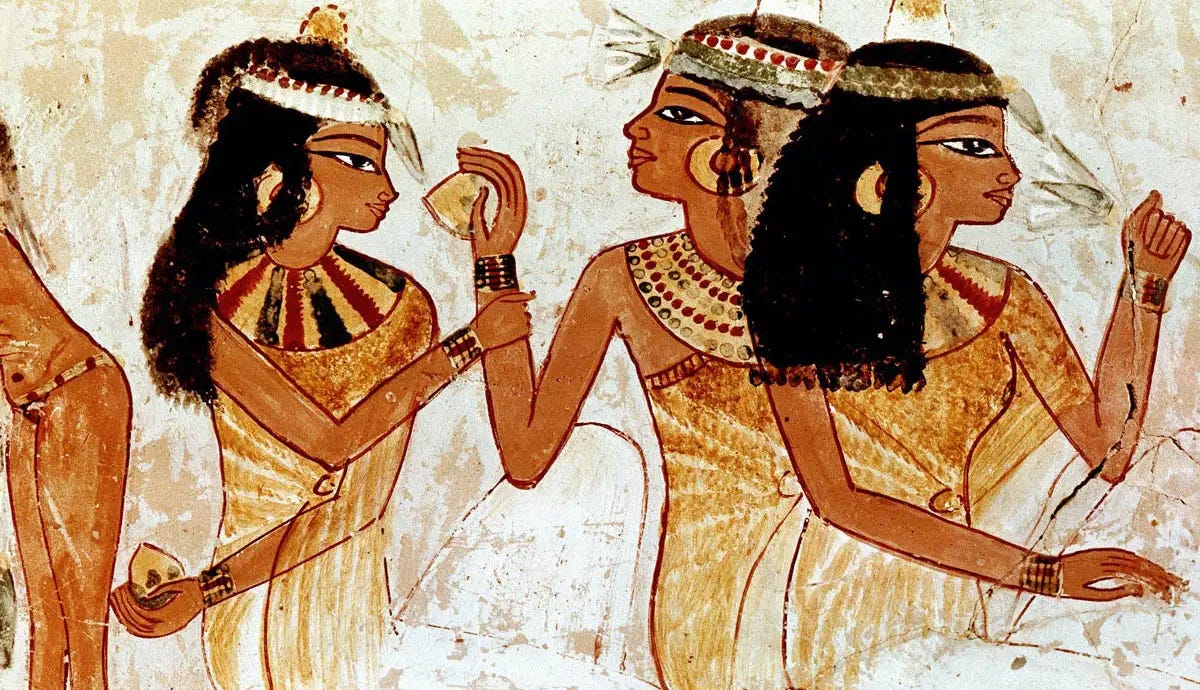Ancient Egypt was based on the central cultural value of Ma’at, or harmony. Harmony and balance extended to every domain of human life, including politics, religion, art, architecture, and even gender roles.
Compared to most other ancient societies, Egyptian women were relatively equal to their male counterparts. Women were free to choose their husbands, and could divorce them. They could own property, travel freely, and had some choice over their profession. Men generally held more authority in political roles, while women held more sway in domestic affairs.
Cult of femininity
Within Egyptian religion, female deities held a preeminent role. According to Egyptian creation myths, the world was created by the goddess Neith. Creation of the universe began with primordial waters, personified as Nu and Naunet. There was a cosmic balance of female and male principles.
In the myth of Osiris, the goddess Isis was in charge of resurrecting her husband. She was aided by other goddesses, such as Nephthys, Serket, and Neith to restore Egypt’s balance after Osiris’ brother Set usurped the throne. Beer was patronized by the goddess Tenenet.
Seshat was the goddess of writing and librarians. Tayet was the goddess of weaving. Hathor was the goddess of joy, celebration, and the afterlife. Bastet was the protector of women and their secrets, as well as the home. Tefnut was the goddess of moisture. The goddess Kabechet, the daughter of Anubis, brought refreshingly cool water to deceased souls awaiting judgment. Other goddesses, such as Nephthys, were associated with the consolations of the afterlife.
Egyptian religion revered femininity. Women were admitted as priestesses and religious leaders in temple life. High priestesses were regarded as wives of the gods, and this role gained increased social and political prestige over time. Women also served as scribes and interpreters of dreams. Dreams were seen as a way for the dead to communicate with the living.
Professional jobs
Women served as teachers and doctors. Female physicians were particularly respected. Scribes were filled by women, usually those from a family of scribes. Other professions included bakers, weavers, brewers, cooks, and household mistresses. Women were the first to brew beer in Egypt, a drink esteemed as a beverage of the gods. Daughters inherited property from their mothers. If a husband died or left the home, it became the domain of the woman.
Concubinage was a common practice. Such women provided sex, but were also distinguished in many other areas. This included music, conversation, sewing, weaving, culture, fashion, and the arts.
Marriage and family life
Women were regarded as the legal equals of men. They did not require supervision from men. This extended to family life as well.
Marriages were not arranged by male guardians, as was common practice in ancient cultures. Women were free to choose their own husbands, and could divorce as they pleased. Although a lifelong marriage was the goal, there was no stigma imposed on a woman who divorced her husband.
Couples before marriage entered into prenuptial agreements, which favored the women. A man who divorced his wife could not sue to get his marriage gifts back. He was also required to pay alimony to the wife until she remarried, or until she requested that it stop. Child custody was always awarded to the mother.
The Ebers Medical Papyrus, dating to around 1542 BC, contains information about birth control. Contraception and abortion were available for both married and unmarried women.
Women freely congregated with men in public. They danced, drank, and worked together in the fields.
Queens
The Queen of Egypt, as well as the King’s lesser wives, lived in opulence and splendor. Concubines and other women took up residence in royal palaces.
Pharaohs could have multiple queens, but there was always a principal wife. The wife acted as a diplomat, and participated in administrative affairs. During the religious reforms of Akhenaten, his wife Nerfertiti assumed responsibility for running the Egyptian state.
The lives of most queens are not well-documented, but it is generally agreed that they were powerful figures who wielded influence over their husbands, their courts, and the day-to-day runnings of the Egyptian government.
There were Egyptian queens as far back as the Early Dynastic period. Queen Meredith ruled as regent for her son around 3000 BC. So did Sobeknefru, who assumed the throne in the Middle Kingdom. There was Hatshepsut, who depicted herself with a pharaonic headdress and beard. She was one of Egypt’s most powerful political figures. The last queen of Egypt, before its annexation by the Roman Empire, was the famous Cleopatra VII.
Learn More





